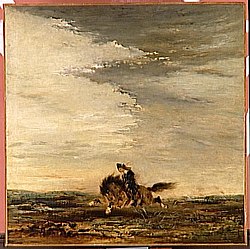You can help expand this article with text translated from the corresponding article in French. (February 2023) Click for important translation instructions.
|

Scottish Horseman, Pony or Horseman is an 1870s oil on canvas painting by Gustave Moreau, enlarging an earlier painting also entitled Horseman - both works are now in the Musée Gustave Moreau.
The artist's last Romantic work, it was strongly inspired by Eugène Delacroix (especially his Tam O'Shanter and the importance it assigns to the sky, a painting inspired by Robert Burns' ballad Tam O'Shanter). Moreau knew Delacroix and went to his studio after setbacks at the Paris Salons - Tam O'Shanter was still there in 1849 and it may have been there where Moreau saw it. Moreau also painted Galloping Pony (1865-1880), a wax sculpture which he may have used as a model for this painting.
Context

Moreau often painted and drew horses during his Romantic period and was probably encouraged to do so by Pierre-Joseph Dedreux-Dorcy, whose favourable opinion had decided the young painter's career.
References
- (in French) Musée Cernuschi. et Musée de la Compagnie des Indes (Lorient, France), L'Inde de Gustave Moreau : Musée Cernuschi, Paris, 15 février-17 mai 1997, Musée de la compagnie des Indes, Lorient, 17 juin-15 septembre 1997., Paris, Musées de la ville de Paris, 1997, 256 p. (ISBN 2-87900-302-4 et 978-2-87900-302-3, OCLC 37095515, SUDOC 004173767)
- (in French) Geneviève Lacambre, Gustave Moreau : Maître Sorcier, Paris, Gallimard et Réunion des musées nationaux, 1997, 128 p. (ISBN 2-07-053388-3, SUDOC 004107926)
- (in French) Pierre-Louis Mathieu and Geneviève Lacambre, Le Musée Gustave Moreau, Paris, Réunion des musées nationaux, 1997, 127 p. (ISBN 2-7118-3479-4), p. 82
- (in French) Pierre-Louis Mathieu, Gustave Moreau : L'assembleur de rêves, Courbevoie, ACR Édition, 1998, 192 p. (ISBN 2-86770-115-5), p. 25
- (in French) Pierre-Louis Mathieu, Gustave Moreau, Paris, Flammarion, 1994 (ISBN 2-08-011743-2), p. 30
- (in French) Geneviève Lacambre, Douglas W. Druick, Larry J. Feinberg and Susan Stein (translated from English), Gustave Moreau 1826-1898, Tours, Réunion des musées nationaux, 1998, 292 p. (ISBN 2-7118-3577-4), p. 115
- (in French) Pierre-Louis Mathieu, Gustave Moreau : L'assembleur de rêves, Courbevoie, ACR Édition, 1998, 192 p. (ISBN 2-86770-115-5), p. 16
- (in French) Pierre-Louis Mathieu, Gustave Moreau, Paris, Flammarion, 1994 (ISBN 2-08-011743-2, p.30
| Gustave Moreau | |
|---|---|
| Paintings |
|
| Museums | |
| Related | |
This article about a nineteenth-century painting is a stub. You can help Misplaced Pages by expanding it. |